Other Parts Discussed in Thread: TPS650861, BOOSTXL-TPS650861
Hi team,
I got a question from customer.
The problem of tps6508641
1: Built in OTP can be programmed to control whether the output voltage of the power chip conflicts with the user operation register;
2: When the user operates the register through IIC bus, why does the corresponding power supply not output the corresponding voltage when writing the voltage value of buckxvid register; In addition to writing voltage value to buckxvid power register, is there any other operation;
3: The default device address of power chip is 0x5e. How to change the default device address of power chip;
4: Can I hang several power chips on an IIC bus?
5: Whether the output voltage of the buck1 of tps6508641 is 5V when it is powered on does not require any operation;

Thank you very much for your help.
Best regards,

